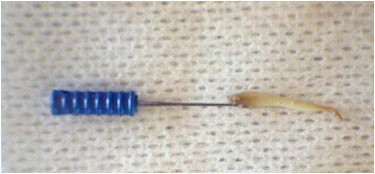The Broach- An Underutilized Time Saver
|
A broach is really nothing more than a small piece of barbed wire that is used to engage the pulp and attempt to remove it in its entirety. As simple as it sounds, the “art” (and it IS truly an art) of snagging a pulp in this manner is analogous to that of setting a hook when catching a trophy bass. Many initially try but it takes practice and skill to decide when the barbs are set and when to pull out the broach. The technique is as follows:
|

Figure 1: Brached Anetrior ToothPulp
Pulp Removed intact speeds treatment

Figure 2: Pulp entangled in Broach Barbs
The pulp is notmeant to be severed with this instrument, it is meant to be entangled and removed intact if possible.
One of the most critical skills that need to be developed is that of broach size selection. In many cases, you only get one or two tries before the pulp is severed into pieces. It is important to select a broach that is smaller than the diameter of the canal but not too small that it merely punctures the pulp and does not engage it. If that happens, go to a larger size and repeat the procedure. If the broach is too large, generally it will not fit very far into the canal without resistance. Forcing the broach at this point risks loss of the barbs or fracture of the instrument. Broaches are notoriously difficult to remove in deeper sections of the canal because of their barbs. If you are unsure, always select a smaller size. You can always move up a size if the pulp does not engage.
